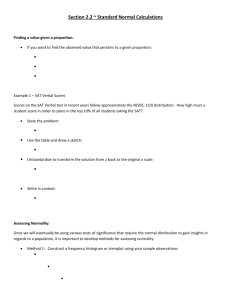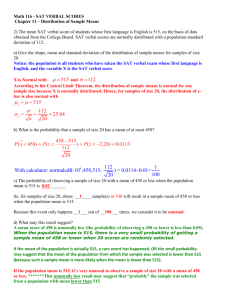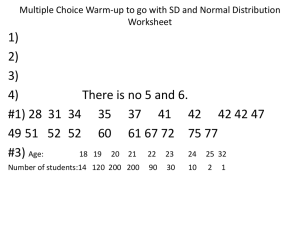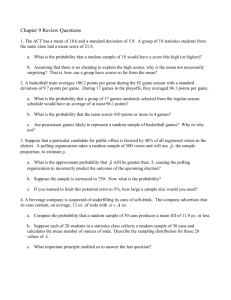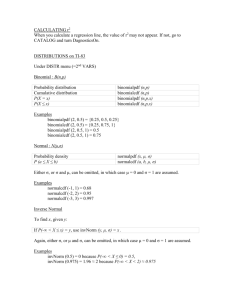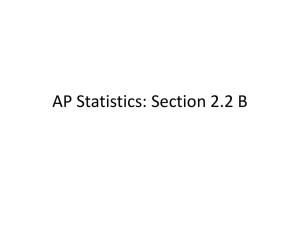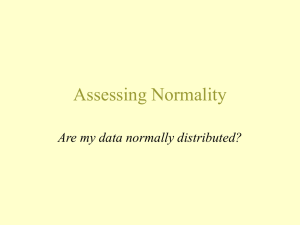Sec. 2.2 Part 2 PowerPoint
advertisement
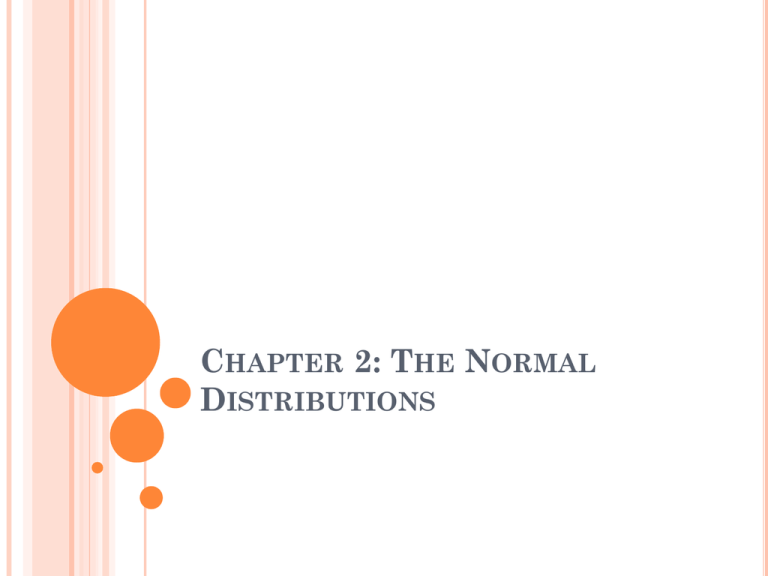
CHAPTER 2: THE NORMAL DISTRIBUTIONS FINDING A VALUE GIVEN A PROPORTION If you want to find the observed value that pertains to a given proportion: Use the standard normal table backwards to “unstandardize” Find the given proportion in the body of the table and determine the z-score that corresponds Multiply that z-score by the value of 1 St.Dev. and then add or subtract it from the value of the mean EXAMPLE 1: SAT VERBAL SCORES Scores on the SAT Verbal test in recent years follow approximately the N(505, 110) distribution. How high must a student score in order to place in the top 10% of all students taking the SAT? State the problem: We want to find the SAT score x with area .1 to its right, which means .9 will be to its left Use the table and draw a sketch: .9 on the table corresponds best to z = 1.28 x 505 z0 x? z 1.28 EXAMPLE 1: SAT VERBAL SCORES Unstandardize to transform the solution from z back to the original x scale: x 505 1.28 110 x 505 140.8 x 505 110 1.28 110 110 x 645.8 Write in context: A person with a score of 645.8 or higher on the SAT Verbal test would be in the top 10% of all students taking the test. QUICK CHECK Do #24c on p.103 ASSESSING NORMALITY Since we will eventually be using various tests of significance that require the normal distibution to gain insights in regards to a population, it is important to develop methods for assessing normality. Method 1: Construct a frequency histogram or stemplot using your sample observations See if the graph is approximately bell shaped and symmetric about the mean Do this by finding the mean ( x ) and St.Dev. (s) of the sample observations and compare the count of observations to the 68-95-99.7 rule See example 2.11 on p.104 ASSESSING NORMALITY Method 2: Construct a normal probability plot using your graphing calculator Enter the values in L1 First go to STAT/CALC/1-VarStats to compare the mean and median If the values are approximately normal, then the mean and median should be close to one another To construct a normal probability plot: Go to 2nd/Y=, turn the plot ON, choose the last type of graph (normal probability plot), and then choose ZOOM9 (ZoomStat) If the data is close to normal, the plotted points will lie close to a straight line If the data are nonnormal, there will be a nonlinear trend ASSESSING NORMALITY Method 2: Construct a boxplot using your graphing calculator Enter the values in L1 First go to STAT/CALC/1-VarStats to compare the mean and median To construct a boxplot: If the values are approximately normal, then the mean and median should be close to one another Go to 2nd/Y=, turn the plot ON, choose the 4th graph (boxplot with outliers), and then choose Zoom9 Look for symmetry Make sure the whiskers extend far enough in comparison to the box On the AP exam you must show that you verified the assumption of normality and since boxplots are much easier to display than normal probability plots, this is typically the method of choice Method 3: Make a graph and look at it While this method is the least mathematical, it is still acceptable to just make a graph and look at it to determine if it appears to be approximately normal EXAMPLE 2 - ASSESSING NORMALITY Use the TI-83/84 to construct a normal probability plot as well as a boxplot for the following sets of data, and use the plots to assess the normality of the data. Data set A: Normal probability plot: there is a nonlinear trend, so it does not take on a normal shape Boxplot: It is right skewed and therefore does not take on a normal shape Data set B: Normal probability plot: Aside from one outlier, it takes on a linear trend and is therefore approximately normal Boxplot: Aside from one outlier, the boxplot appears to be fairly symmetric and is therefore considered approximately normal FINDING AREAS WITH NORMALCDF The normalcdf command on the TI-83/84 can be used to find the area under a normal distribution and above an interval Press 2nd/VARS/normalcdf( Enter the (lower bound, upper bound, mean, st.dev.) If you want the area to the left, then pick an extremely low value to represent the lower bound (which is theoretically negative infinity) If you want the area to the right, then pick an extremely high value to represent the upper bound (which is theoretically positive infinity) EXAMPLE 3 – USING NORMALCDF Scores on the SAT Verbal test in recent years follow approximately the N(505, 110) distribution. What is the proportion of scores that are below 400? normalcdf(-1000,400,505,110) About 17% of all tests will have a score lower than 400 What is the proportion of scores that are above 600? normalcdf(600,2000,505,110) About 19% of all tests will have a score higher than 600 What is the proportion of scores that are between 480 and 650? normalcdf(480,650,505,110) About 50% of all tests will have a score between 480 and 650 QUICK CHECK Redo #23a & b on p.103 using calc FINDING Z-SCORES WITH INVNORM The invNorm function calculates the raw or standardized normal value corresponding to a known area under a normal distribution Press 2nd/VARS/invNorm( For the actual raw value: Enter the (area, mean, st.dev.) For the standardized value (z-score): Enter invNorm(area) EXAMPLE 4 – USING INVNORM Scores on the SAT Verbal test in recent years follow approximately the N(505, 110) distribution. How high must a student score in order to place in the top 15% of all students taking the SAT? The top 15% corresponds to the 85th percentile invNorm(.85,505,110) A student must score a 619 or higher to be in the top 15% of all students on the SAT Verbal test. QUICK CHECK #43 on p.113 using calc SECTION 2.2 DAY 2 HOMEWORK P.103-114 #’s 22, 23c, 25, 27, 30, 31c, 33, & 47
